今天我们一起来学习下Rootkit里面的IDT hook. 由于涉及到一些基本概念,在这里也顺便提一下。呵呵,帖子比较长,慢慢看。闲话少说,直奔主题。
我们首先来了解下什么是IDT?
IDT = Interrupt Descriptor Table 中断描述表
IDT是一个有256个入口的线形表,每个IDT的入口是个8字节的描述符,所以整个IDT表的大小为256*8=2048 bytes,每个中断向量关联了一个中断处理过程。所谓的中断向量就是把每个中断或者异常用一个0-255的数字识别。Intel称这个数字为向量(vector).如图所示。
对于中断描述表,操作系统使用IDTR寄存器来记录idt位置和大小。
IDTR寄存器是48位寄存器,用于保存idt信息。其中低16位代表IDT的大小,大小为7FFH,高32位代表IDT的基地址。在我的机器上,基地址是8003F400H. 我们可以利用指令sigt读出IDTR寄存器中的信息,从而找到IDT在内存中的位置。
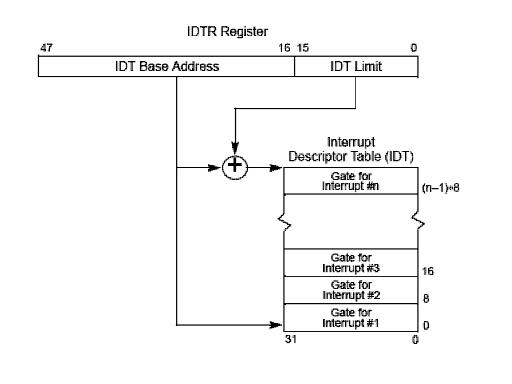
IDT有三种不同的描述符或者说是入口,分别是:
1。任务门描述符
2。中断门描述符
3。陷阱门描述符
也就是说,在保护模式下,80386只有通过中断门、陷阱门或任务门才能转移到对应的中断或异常处理程序。
Intel参考手册上指出“同步中断”(在一个指令执行完成后,由CPU控制单元产生的)作为“异常”。
异步中断(可能会在任意时刻由其他硬件产生的)才称为“中断”。中断被外部的I/O设备产生。
但是异常是由编程错误或者是由反常情况(必须由内核来处理)触发的。在该文档中,
术语“中断信号”既指异常又指中断。
中断分为两种类型:可屏蔽中断--它在短时间片段里可被忽略;不可屏蔽中断--它必须被立即处理。例如:硬件失败为不可屏蔽中断,IRQS(中断请求)失败为可屏蔽中断。
异常被分为不同的两类:处理器产生的异常(Faults, Traps, Aborts)和编程安排的异常(用汇编指令int or int3 触发)。后一种就是我们经常说到的软中断。
我们先看看这三种描述符:
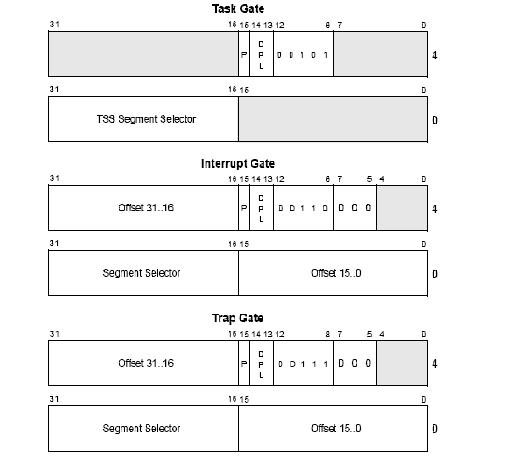
其中:后两种描述符,非常的相似,只有1个bit位的差别。在处理上,采用相同的处理方式。如图所示,在这后两类的描述符里面记录了一个中断服务程序(ISR )的地址offset. 在IDT的256个向量中,除3个任务门入口外,其他都是这两种门的入口。并且所有的trap/interrupt gate的入口,他们的segment selector都是一样的,即:08h. 我们察看GDT中Selector = 8的描述符,描述的是00000000h ~ 0ffffffffh的4G地址空间。 因此,在描述符中的中断服务程序(ISR )的地址offset就代表了函数的入口地址。windows在处理的时候,按照下图方式,来处理这两类的描述符入口。即:根据segment selector在GDT中找出段基地址等信息,然后跟描述符中的中断服务程序(ISR )的地址offset相加得到代码段中的函数入口地址。然后调用该函数。
这个过程,我写得比较直接,在操作系统执行这过程时,还有很多的出错判断和异常保护,这里我们略过。
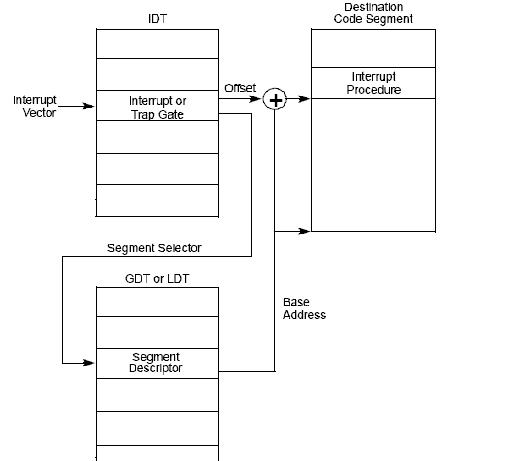
接下来,我们看看任务门描述符的情况。

首先,根据IDT中任务门描述符的TSS Segment Selector ,我们在GDT中找出这个选择子。在这个选择子中,对应一个tss描述符,即:任务状态段描述符。这个描述符大小为068h, 即104字节。
下面是这个任务状态段描述符的格式。
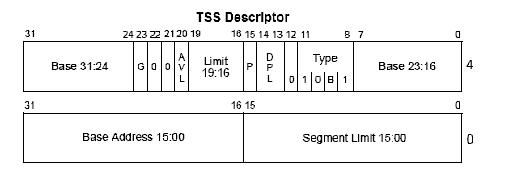
我们看到在这个描述符中记录了任务状态段的位置和大小。
我们根据任务状态段描述符中的base Address, 找到TSS的内存位置。然后我们就可以进行任务切换。所谓任务切换是指,挂起当前正在执行的任务,恢复或启动另一任务的执行。在任务切换过程中,首先,处理器中各寄存器的当前值被自动保存到TR所指定的TSS中;然后,下一任务的TSS的选择子被装入TR;最后,从TR所指定的TSS中取出各寄存器的值送到处理器的各寄存器中。由此可见,通过在TSS中保存任务现场各寄存器状态的完整映象,实现任务的切换。 TR寄存器可见部分保存了tss selector, 不可见部分,保存了任务状态段的位置和大小.如下图所示。
任务状态段TSS的基本格式如下图所示。
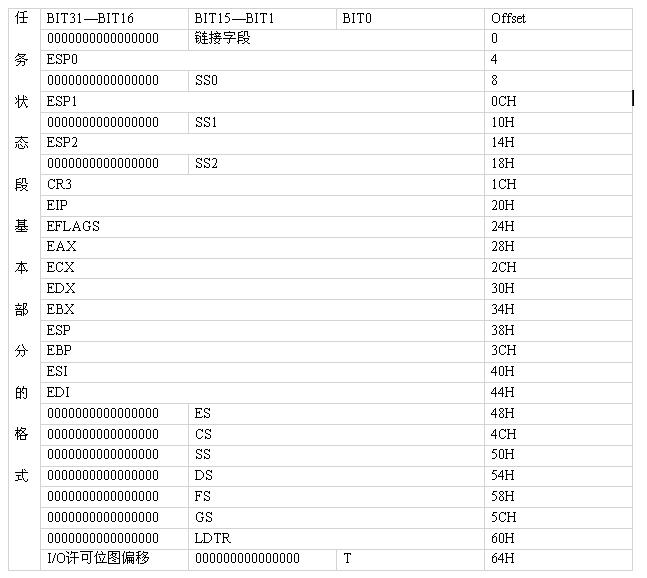
从图中可见,TSS的基本格式由104字节组成。这104字节的基本格式是不可改变的,但在此之外系统软件还可定义若干附加信息。
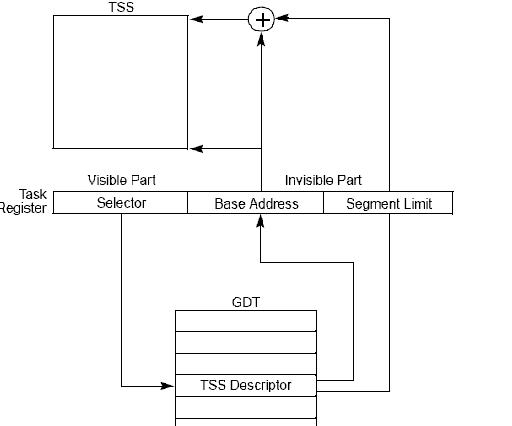
理论的部分,我们简单介绍这么多。接下来,我们透过几个例子来说明下,IDT HOOK。
一。透过一个简单的代码,看看256个中断向量对应的ISR., 其中任务门的ISR没有,由于整个IDT中只有3个任务门,我们忽略这部分。代码如下:
#include "ntddk.h"
#include <stdio.h>
#define MAKELONG(a, b) ((unsigned long) (((unsigned short) (a)) | ((unsigned long) ((unsigned short) (b))) << 16))
#define MAX_IDT_ENTRIES 0xFF
#pragma pack(1)
// entry in the IDT, this is sometimes called
// an "interrupt gate"
typedef struct
{
unsigned short LowOffset;
unsigned short selector;
unsigned char unused_lo;
unsigned char segment_type:4; //0x0E is an interrupt gate
unsigned char system_segment_flag:1;
unsigned char DPL:2; // descriptor privilege level
unsigned char P:1; /* present */
unsigned short HiOffset;
} IDTENTRY;
/* sidt returns idt in this format */
typedef struct
{
unsigned short IDTLimit;
unsigned short LowIDTbase;
unsigned short HiIDTbase;
} IDTINFO;
#pragma pack()
VOID OnUnload( IN PDRIVER_OBJECT DriverObject )
{
DbgPrint("ROOTKIT: OnUnload called\n");
}
NTSTATUS DriverEntry( IN PDRIVER_OBJECT theDriverObject, IN PUNICODE_STRING theRegistryPath )
{
IDTINFO idt_info;
IDTENTRY* idt_entries;
unsigned long count;
theDriverObject->DriverUnload = OnUnload;
// load idt_info
__asm sidt idt_info
idt_entries = (IDTENTRY*) MAKELONG(idt_info.LowIDTbase,idt_info.HiIDTbase);
for(count=0;count < MAX_IDT_ENTRIES;count++)
{
char _t[255];
IDTENTRY *i = &idt_entries[count];
unsigned long addr = 0;
addr = MAKELONG(i->LowOffset, i->HiOffset);
_snprintf(_t, 253, "Interrupt %d: ISR 0x%08X", count, addr);
DbgPrint(_t);
}
return STATUS_SUCCESS;
}
我们使用DebugView工具软件,就可以看到打印出来的信息。
二、直接替换idt中某个中断向量的ISR.
这里采用的办法是,首先保存出中断向量0x30的ISR, 然后直接修改中断向量0x30的ISR为我们自定义的函数 my_interrupt_hook,每当0x30号中断产生,就会调用我们自定义的函数。
由于我们自定义的函数里面执行完我们的功能后再跳转到原isr函数处执行。因此这种hook用户感觉不到,不影响原有功能。在OnUnload时,恢复原有的中断向量ISR.
#include "ntddk.h"
#include <stdio.h>
#define MAKELONG(a, b) ((unsigned long) (((unsigned short) (a)) | ((unsigned long) ((unsigned short) (b))) << 16))
#define MAX_IDT_ENTRIES 0xFF
#define NT_INT_TIMER 0x30
unsigned long g_i_count = 0;
///////////////////////////////////////////////////
// IDT structures
///////////////////////////////////////////////////
#pragma pack(1)
// entry in the IDT, this is sometimes called
// an "interrupt gate"
typedef struct
{
unsigned short LowOffset;
unsigned short selector;
unsigned char unused_lo;
unsigned char segment_type:4; //0x0E is an interrupt gate
unsigned char system_segment_flag:1;
unsigned char DPL:2; // descriptor privilege level
unsigned char P:1; /* present */
unsigned short HiOffset;
} IDTENTRY;
/* sidt returns idt in this format */
typedef struct
{
unsigned short IDTLimit;
unsigned short LowIDTbase;
unsigned short HiIDTbase;
} IDTINFO;
#pragma pack()
unsigned long old_ISR_pointer; // better save the old one!!
VOID OnUnload( IN PDRIVER_OBJECT DriverObject )
{
IDTINFO idt_info; // this structure is obtained by calling STORE IDT (sidt)
IDTENTRY* idt_entries; // and then this pointer is obtained from idt_info
char _t[255];
// load idt_info
__asm sidt idt_info
idt_entries = (IDTENTRY*) MAKELONG(idt_info.LowIDTbase,idt_info.HiIDTbase);
DbgPrint("ROOTKIT: OnUnload called\n");
_snprintf(_t, 253, "called %d times", g_i_count);
DbgPrint(_t);
DbgPrint("UnHooking Interrupt...");
// restore the original interrupt handler
__asm cli
idt_entries[NT_INT_TIMER].LowOffset = (unsigned short) old_ISR_pointer;
idt_entries[NT_INT_TIMER].HiOffset = (unsigned short)((unsigned long)old_ISR_pointer >> 16);
__asm sti
DbgPrint("UnHooking Interrupt complete.");
}
// using stdcall means that this function fixes the stack before returning (opposite of cdecl)
void __stdcall count_syscall( unsigned long system_call_number )
{
g_i_count++;
}
// naked functions have no prolog/epilog code - they are functionally like the
// target of a goto statement
__declspec(naked) my_interrupt_hook()
{
__asm
{
push eax
call count_syscall
jmp old_ISR_pointer
}
}
NTSTATUS DriverEntry( IN PDRIVER_OBJECT theDriverObject, IN PUNICODE_STRING theRegistryPath )
{
IDTINFO idt_info; // this structure is obtained by calling STORE IDT (sidt)
IDTENTRY* idt_entries; // and then this pointer is obtained from idt_info
IDTENTRY* i;
unsigned long addr;
unsigned long count;
char _t[255];
theDriverObject->DriverUnload = OnUnload;
// load idt_info
__asm sidt idt_info
idt_entries = (IDTENTRY*) MAKELONG(idt_info.LowIDTbase,idt_info.HiIDTbase);
for(count=0;count < MAX_IDT_ENTRIES;count++)
{
i = &idt_entries[count];
addr = MAKELONG(i->LowOffset, i->HiOffset);
_snprintf(_t, 253, "Interrupt %d: ISR 0x%08X", count, addr);
DbgPrint(_t);
}
DbgPrint("Hooking Interrupt...");
// lets hook an interrupt
// exercise - choose your own interrupt
old_ISR_pointer = MAKELONG(idt_entries[NT_INT_TIMER].LowOffset,idt_entries[NT_INT_TIMER].HiOffset);
// debug, use this if you want some additional info on what is going on
#if 0
_snprintf(_t, 253, "old address for ISR is 0x%08x", old_ISR_pointer);
DbgPrint(_t);
_snprintf(_t, 253, "address of my function is 0x%08x", my_interrupt_hook);
DbgPrint(_t);
#endif
// remember we disable interrupts while we patch the table
__asm cli
idt_entries[NT_INT_TIMER].LowOffset = (unsigned short)my_interrupt_hook;
idt_entries[NT_INT_TIMER].HiOffset = (unsigned short)((unsigned long)my_interrupt_hook >> 16);
__asm sti
// debug - use this if you want to check what is now placed in the interrupt vector
#if 0
i = &idt_entries[NT_INT_TIMER];
addr = MAKELONG(i->LowOffset, i->HiOffset);
_snprintf(_t, 253, "Interrupt ISR 0x%08X", addr);
DbgPrint(_t);
#endif
DbgPrint("Hooking Interrupt complete");
return STATUS_SUCCESS;
}
三、这个示例中hook 了整个idt表,采用的方式是:
1)首先保留出每个中断向量的ISR. 为每一个中断向量的调用设置了一个计数器,并将计数器清零。
2)为整个IDT建立一个detour内存表,内存表中的每一项对应于每个中断向量。每一项的空间中保存了一个函数,在这个函数中,会调用一个公共的计数函数,用于统计每个中断ISR调用的次数,函数的最后会调用该中断向量原ISR.
3)修改IDT表中的每一个中断向量ISR为detour内存表中相应项的函数。
4)OnUnload中打印出每个中断向量ISR调用的次数,并恢复原ISR.
#include "ntddk.h"
#include <stdio.h>
#define MAKELONG(a, b) ((unsigned long) (((unsigned short) (a)) | ((unsigned long) ((unsigned short) (b))) << 16))
// set this to the max int you want to hook
#define MAX_IDT_ENTRIES 0xFF
// the starting interrupt for patching
// to 'skip' some troublesome interrupts
// at the beginning of the table (TODO, find out why)
#define START_IDT_OFFSET 0x00
unsigned long g_i_count[MAX_IDT_ENTRIES];
unsigned long old_ISR_pointers[MAX_IDT_ENTRIES]; // better save the old one!!
#ifdef _DEBUG
// debuggering version nops out our 'hook'
// this works w/ no crashes
char jump_template[] = {
0x90, //nop, debug
0x60, //pushad
0x9C, //pushfd
0xB8, 0xAA, 0x00, 0x00, 0x00, //mov eax, AAh
0x90, //push eax
0x90, 0x90, 0x90, 0x90, 0x90, 0x90, 0x90, //call 08:44332211h
0x90, //pop eax
0x9D, //popfd
0x61, //popad
0xEA, 0x11, 0x22, 0x33, 0x44, 0x08, 0x00 //jmp 08:44332211h
};
#else
char jump_template[] = {
0x90, //nop, debug
0x60, //pushad
0x9C, //pushfd
0xB8, 0xAA, 0x00, 0x00, 0x00, //mov eax, AAh
0x50, //push eax
0x9A, 0x11, 0x22, 0x33, 0x44, 0x08, 0x00, //call 08:44332211h
0x58, //pop eax
0x9D, //popfd
0x61, //popad
0xEA, 0x11, 0x22, 0x33, 0x44, 0x08, 0x00 //jmp 08:44332211h
};
#endif
char * idt_detour_tablebase;
///////////////////////////////////////////////////
// IDT structures
///////////////////////////////////////////////////
#pragma pack(1)
// entry in the IDT, this is sometimes called
// an "interrupt gate"
typedef struct
{
unsigned short LowOffset;
unsigned short selector;
unsigned char unused_lo;
unsigned char segment_type:4; //0x0E is an interrupt gate
unsigned char system_segment_flag:1;
unsigned char DPL:2; // descriptor privilege level
unsigned char P:1; /* present */
unsigned short HiOffset;
} IDTENTRY;
/* sidt returns idt in this format */
typedef struct
{
unsigned short IDTLimit;
unsigned short LowIDTbase;
unsigned short HiIDTbase;
} IDTINFO;
#pragma pack()
VOID OnUnload( IN PDRIVER_OBJECT DriverObject )
{
int i;
IDTINFO idt_info; // this structure is obtained by calling STORE IDT (sidt)
IDTENTRY* idt_entries; // and then this pointer is obtained from idt_info
char _t[255];
// load idt_info
__asm sidt idt_info
idt_entries = (IDTENTRY*) MAKELONG(idt_info.LowIDTbase,idt_info.HiIDTbase);
DbgPrint("ROOTKIT: OnUnload called\n");
for(i=START_IDT_OFFSET;i<MAX_IDT_ENTRIES;i++)
{
_snprintf(_t, 253, "interrupt %d called %d times", i, g_i_count[i]);
DbgPrint(_t);
}
DbgPrint("UnHooking Interrupt...");
for(i=START_IDT_OFFSET;i<MAX_IDT_ENTRIES;i++)
{
// restore the original interrupt handler
__asm cli
idt_entries[i].LowOffset = (unsigned short) old_ISR_pointers[i];
idt_entries[i].HiOffset = (unsigned short)((unsigned long)old_ISR_pointers[i] >> 16);
__asm sti
}
DbgPrint("UnHooking Interrupt complete.");
}
// using stdcall means that this function fixes the stack before returning (opposite of cdecl)
// interrupt number passed in EAX
void __stdcall count_interrupts(unsigned long inumber)
{
//todo, may have collisions here?
unsigned long *aCountP;
unsigned long aNumber;
// due to far call, we need to correct the base pointer
// the far call pushes a double dword as the return address
// and I don't know how to make the compiler understand this
// is a __far __stdcall (or whatever it's called)
// anyway:
//
// [ebp+0Ch] == arg1
//
__asm mov eax, [ebp+0Ch]
__asm mov aNumber, eax
//__asm int 3
aNumber = aNumber & 0x000000FF;
aCountP = &g_i_count[aNumber];
InterlockedIncrement(aCountP);
}
NTSTATUS DriverEntry( IN PDRIVER_OBJECT theDriverObject, IN PUNICODE_STRING theRegistryPath )
{
IDTINFO idt_info; // this structure is obtained by calling STORE IDT (sidt)
IDTENTRY* idt_entries; // and then this pointer is obtained from idt_info
IDTENTRY* i;
unsigned long addr;
unsigned long count;
char _t[255];
theDriverObject->DriverUnload = OnUnload;
for(count=START_IDT_OFFSET;count<MAX_IDT_ENTRIES;count++)
{
g_i_count[count]=0;
}
// load idt_info
__asm sidt idt_info
idt_entries = (IDTENTRY*) MAKELONG(idt_info.LowIDTbase,idt_info.HiIDTbase);
////////////////////////////////////////////
// save old idt pointers
////////////////////////////////////////////
for(count=START_IDT_OFFSET;count < MAX_IDT_ENTRIES;count++)
{
i = &idt_entries[count];
addr = MAKELONG(i->LowOffset, i->HiOffset);
_snprintf(_t, 253, "Interrupt %d: ISR 0x%08X", count, addr);
DbgPrint(_t);
old_ISR_pointers[count] = MAKELONG(idt_entries[count].LowOffset,idt_entries[count].HiOffset);
}
///////////////////////////////////////////
// setup the detour table
///////////////////////////////////////////
idt_detour_tablebase = ExAllocatePool(NonPagedPool, sizeof(jump_template)*256);
for(count=START_IDT_OFFSET;count<MAX_IDT_ENTRIES;count++)
{
int offset = sizeof(jump_template)*count;
char *entry_ptr = idt_detour_tablebase + offset;
// entry_ptr points to the start of our jump code in the detour_table
// copy the starter code into the template location
memcpy(entry_ptr, jump_template, sizeof(jump_template));
#ifndef _DEBUG
// stamp the interrupt number
entry_ptr[4] = (char)count;
// stamp the far call to the hook routine
*( (unsigned long *)(&entry_ptr[10]) ) = (unsigned long)count_interrupts;
#endif
// stamp the far jump to the original ISR
*( (unsigned long *)(&entry_ptr[20]) ) = old_ISR_pointers[count];
// finally, make the interrupt point to our template code
__asm cli
idt_entries[count].LowOffset = (unsigned short)entry_ptr;
idt_entries[count].HiOffset = (unsigned short)((unsigned long)entry_ptr >> 16);
__asm sti
}
DbgPrint("Hooking Interrupt complete");
return STATUS_SUCCESS;
}
后面再附上一个Greg Hoglund的例子,请大家欣赏。
- 标 题:rootkit hook之[四]-- IDT Hook
- 作 者:combojiang
- 时 间:2008-02-19 17:05
- 链 接:http://bbs.pediy.com/showthread.php?t=59867